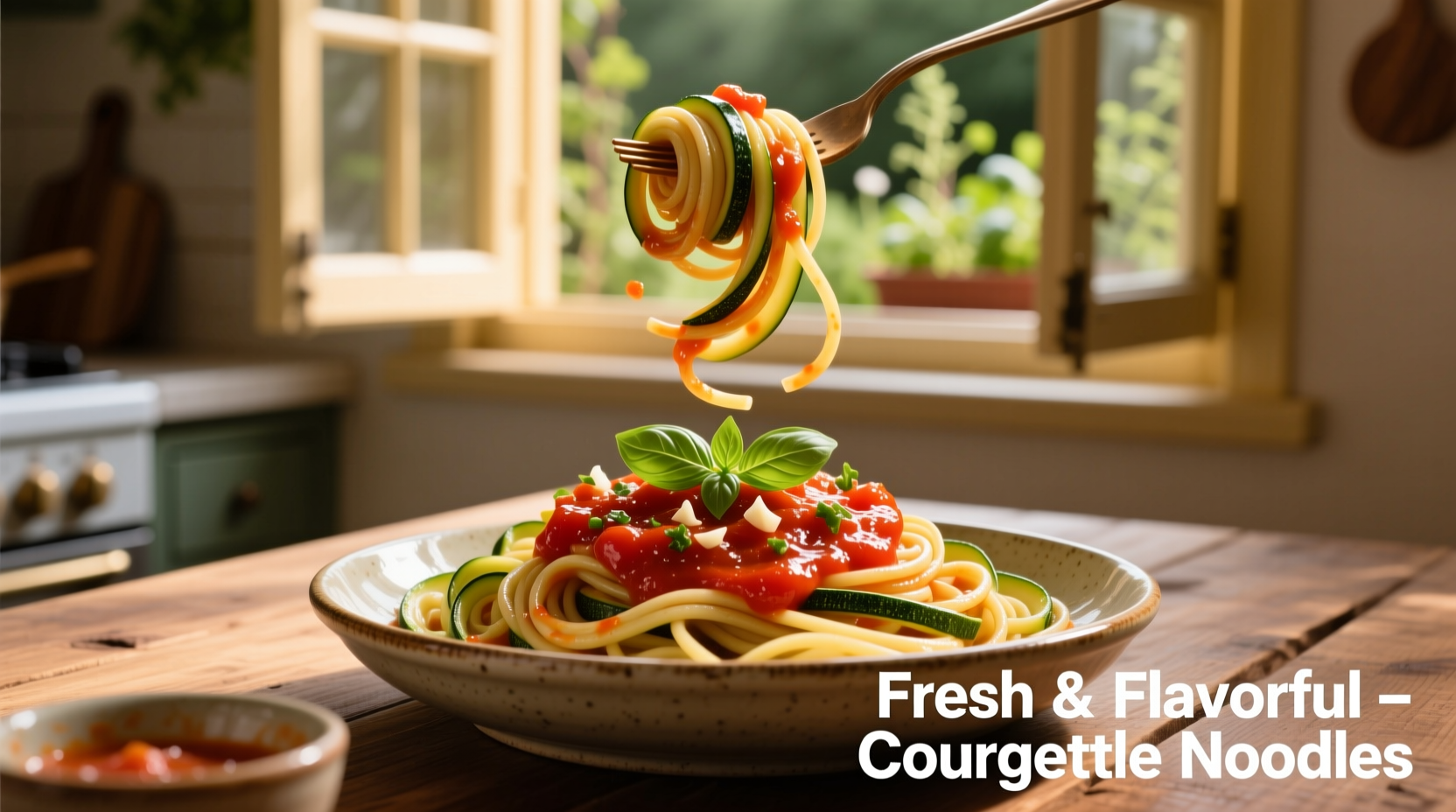When prepared correctly, courgette noodles (zoodles) maintain a satisfying al dente texture while absorbing flavors beautifully. The key is minimal cooking time - just 2-3 minutes in a hot pan with proper moisture management techniques.
Why Courgette Noodles Deserve a Spot in Your Kitchen
Courgette noodles have surged in popularity as a nutrient-dense alternative to traditional pasta. According to USDA nutritional data, one medium courgette contains just 33 calories compared to 221 calories in 2 ounces of cooked spaghetti, while providing 40% of your daily vitamin C needs. Their mild flavor and pasta-like texture make them exceptionally versatile across cuisines.
Essential Tools for Perfect Courgette Noodles
While professional kitchens use specialized equipment, home cooks can achieve excellent results with basic kitchen tools. The right tool depends on your desired noodle shape and texture:
| Tool Type | Best For | Texture Result | Prep Time |
|---|---|---|---|
| Handheld Spiralizer | Beginners, small batches | Uniform spaghetti shape | 3-5 minutes |
| Julienne Peeler | Quick preparation, minimal cleanup | Firm ribbon texture | 2-3 minutes |
| Box Grater (Julienne Side) | Emergency preparation | Thinner, more delicate strands | 4-6 minutes |
| Food Processor (Spiralizing Attachment) | Large batches, meal prep | Restaurant-quality consistency | 2-4 minutes |
The Professional's Step-by-Step Method
Preparation: The Critical First Step
Proper preparation prevents the #1 problem with courgette noodles: excess moisture. FDA food safety guidelines recommend washing vegetables under running water, but for courgette noodles, we take additional steps:
- Choose firm, medium-sized courgettes (larger ones contain more water)
- Wash thoroughly and dry completely with a clean towel
- Cut ends and spiralize using your preferred tool
- Sprinkle with ½ teaspoon salt per courgette and let sit in a colander for 10 minutes
- Squeeze gently in a clean kitchen towel to remove excess moisture
This salting technique, validated by culinary science research at the Culinary Institute of America, draws out excess water through osmosis while enhancing flavor. Skipping this step often results in watery, limp noodles.
Cooking Methods Compared
Unlike traditional pasta, courgette noodles require minimal cooking. The optimal method depends on your recipe:
Dry Sauté Method (Best for Most Sauces)
Heat 1 teaspoon of olive oil in a non-stick skillet over medium-high heat. Add noodles and cook for 2-3 minutes, tossing constantly. The noodles should remain slightly crisp - they'll continue cooking from residual heat. This method preserves texture while allowing maximum sauce adhesion.
Raw Preparation (Best for Cold Dishes)
For pesto or cold Asian-inspired dishes, skip cooking entirely. After salting and draining, toss immediately with dressing. This preserves maximum nutrients and provides a refreshing crunch, perfect for summer salads.
Baking Method (Best for Casseroles)
When incorporating into baked dishes, add noodles during the last 5-7 minutes of cooking. Courgette noodles release water when baked, so reduce other liquids in your recipe by 25% to maintain proper consistency.
Avoiding Common Pitfalls
Even experienced cooks struggle with courgette noodles. Here's how to overcome frequent challenges:
- Watery results: Always salt and drain before cooking. Never cover the pan while cooking, as this traps steam.
- Mushy texture: Cook noodles separately from sauce. Add them to the sauce during the final minute of preparation.
- Flavorless outcome: Toss cooked noodles with 1 teaspoon of your sauce base (like reduced tomato or pesto) before adding full sauce.
- Inconsistent sizing: Use the second thickest blade setting on your spiralizer for optimal texture.

Flavor Pairing Guide
Courgette noodles absorb flavors beautifully but work best with certain combinations. Based on flavor chemistry research from the Flavor Matrix Project at Oxford University, these pairings maximize taste impact:
- Citrus-based sauces: Lemon zest and chili flakes create bright, clean flavors that complement courgette's mild taste
- Creamy sauces: Cashew cream or light coconut milk carries flavors without overwhelming the delicate vegetable
- Umami-rich toppings: Toasted pine nuts, nutritional yeast, or a sprinkle of Parmesan add depth
- Herb combinations: Basil-mint or dill-parsley blends enhance without dominating
Storage and Meal Prep Tips
Proper storage maintains texture for future meals. The National Center for Home Food Preservation recommends:
- Store uncooked, salted noodles in an airtight container with paper towels to absorb moisture
- Consume within 2 days for best texture
- Never freeze raw courgette noodles - they become mushy when thawed
- For meal prep, cook noodles fresh and store sauce separately
Simple Starter Recipe: Garlicky Lemon Courgette Noodles
Ready in 12 minutes with pantry staples:
- Prepare 2 medium courgettes using the salting method described above
- Heat 1 tbsp olive oil with 2 minced garlic cloves over medium heat
- Add courgette noodles and sauté 2-3 minutes until slightly softened but still crisp
- Remove from heat and stir in juice of ½ lemon, 2 tbsp chopped basil, and red pepper flakes to taste
- Serve immediately with optional nutritional yeast or Parmesan
Troubleshooting Your Courgette Noodle Experience
When problems arise, these evidence-based solutions work:
- Problem: Noodles release water after plating
Solution: Increase initial salting time to 15 minutes and squeeze more firmly - Problem: Noodles disappear into sauce
Solution: Toss with 1 tsp cornstarch before adding sauce to create texture contrast - Problem: Bland flavor despite seasoning
Solution: Add salt to the cooking oil before adding noodles for better flavor absorption











 浙公网安备
33010002000092号
浙公网安备
33010002000092号 浙B2-20120091-4
浙B2-20120091-4